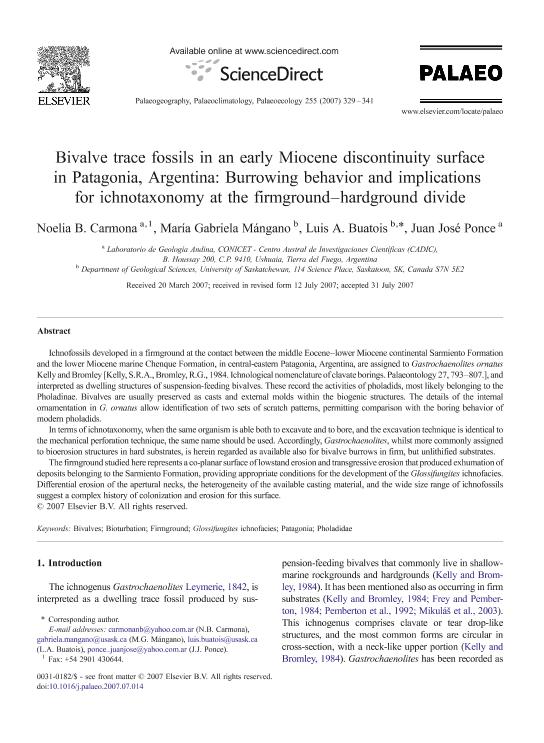Mostrar el registro sencillo del ítem
dc.contributor.author
Carmona, Noelia Beatriz

dc.contributor.author
Mángano, María Gabriela
dc.contributor.author
Buatois, Luis A.
dc.contributor.author
Ponce, Juan Jose

dc.date.available
2022-02-09T11:41:24Z
dc.date.issued
2007-11
dc.identifier.citation
Carmona, Noelia Beatriz; Mángano, María Gabriela; Buatois, Luis A.; Ponce, Juan Jose; Bivalve trace fossils in an early Miocene discontinuity surface in Patagonia, Argentina: Burrowing behavior and implications for ichnotaxonomy at the firmground-hardground divide; Elsevier Science; Palaeogeography, Palaeoclimatology, Palaeoecology; 255; 3-4; 11-2007; 329-341
dc.identifier.issn
0031-0182
dc.identifier.uri
http://hdl.handle.net/11336/151639
dc.description.abstract
Ichnofossils developed in a firmground at the contact between the middle Eocene-lower Miocene continental Sarmiento Formation and the lower Miocene marine Chenque Formation, in central-eastern Patagonia, Argentina, are assigned to Gastrochaenolites ornatus Kelly and Bromley [Kelly, S.R.A., Bromley, R.G., 1984. Ichnological nomenclature of clavate borings. Palaeontology 27, 793-807.], and interpreted as dwelling structures of suspension-feeding bivalves. These record the activities of pholadids, most likely belonging to the Pholadinae. Bivalves are usually preserved as casts and external molds within the biogenic structures. The details of the internal ornamentation in G. ornatus allow identification of two sets of scratch patterns, permitting comparison with the boring behavior of modern pholadids. In terms of ichnotaxonomy, when the same organism is able both to excavate and to bore, and the excavation technique is identical to the mechanical perforation technique, the same name should be used. Accordingly, Gastrochaenolites, whilst more commonly assigned to bioerosion structures in hard substrates, is herein regarded as available also for bivalve burrows in firm, but unlithified substrates. The firmground studied here represents a co-planar surface of lowstand erosion and transgressive erosion that produced exhumation of deposits belonging to the Sarmiento Formation, providing appropriate conditions for the development of the Glossifungites ichnofacies. Differential erosion of the apertural necks, the heterogeneity of the available casting material, and the wide size range of ichnofossils suggest a complex history of colonization and erosion for this surface.
dc.format
application/pdf
dc.language.iso
eng
dc.publisher
Elsevier Science

dc.rights
info:eu-repo/semantics/openAccess
dc.rights.uri
https://creativecommons.org/licenses/by-nc-sa/2.5/ar/
dc.subject
BIOTURBATION
dc.subject
BIVALVES
dc.subject
FIRMGROUND
dc.subject
GLOSSIFUNGITES ICHNOFACIES
dc.subject
PATAGONIA
dc.subject
PHOLADIDAE
dc.subject.classification
Geología

dc.subject.classification
Ciencias de la Tierra y relacionadas con el Medio Ambiente

dc.subject.classification
CIENCIAS NATURALES Y EXACTAS

dc.title
Bivalve trace fossils in an early Miocene discontinuity surface in Patagonia, Argentina: Burrowing behavior and implications for ichnotaxonomy at the firmground-hardground divide
dc.type
info:eu-repo/semantics/article
dc.type
info:ar-repo/semantics/artículo
dc.type
info:eu-repo/semantics/publishedVersion
dc.date.updated
2022-01-06T15:02:55Z
dc.journal.volume
255
dc.journal.number
3-4
dc.journal.pagination
329-341
dc.journal.pais
Países Bajos

dc.journal.ciudad
Amsterdam
dc.description.fil
Fil: Carmona, Noelia Beatriz. Consejo Nacional de Investigaciones Científicas y Técnicas. Centro Austral de Investigaciones Científicas; Argentina
dc.description.fil
Fil: Mángano, María Gabriela. University Of Saskatchewan. Department Geological Sciences;
dc.description.fil
Fil: Buatois, Luis A.. University Of Saskatchewan. Department Geological Sciences;
dc.description.fil
Fil: Ponce, Juan Jose. Consejo Nacional de Investigaciones Científicas y Técnicas. Centro Austral de Investigaciones Científicas; Argentina
dc.journal.title
Palaeogeography, Palaeoclimatology, Palaeoecology

dc.relation.alternativeid
info:eu-repo/semantics/altIdentifier/url/https://www.sciencedirect.com/science/article/pii/S0031018207004105
dc.relation.alternativeid
info:eu-repo/semantics/altIdentifier/doi/https://doi.org/10.1016/j.palaeo.2007.07.014
Archivos asociados
